The Natural Beauty of Tooth Colored Fillings
(Continued)
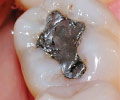 |
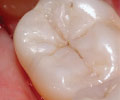 |
| Figure 2: An example of a “direct” composite restoration (right) replacing an older, failing silver filling (left). Courtesy of the CDA journal. | |
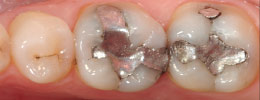 |
|
| Figure 3: A photograph of two molar teeth with old silver fillings that are being replaced. | |
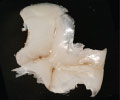 |
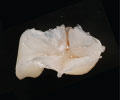 |
| Figure 4: These fillings represent examples of a “semi-direct” composite technique finished outside of the mouth. | |
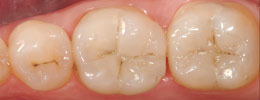 |
|
| Figure 5: A photograph showing the beauty of the “semi-direct” technique restoring the molar teeth to their original appearance. | |
| Photos provided by Dr. Pascal Magne | |
Direct, Semi-Direct or Indirect Restorations
Sounds like the way some people talk. “Direct, Semi-Direct and Indirect” all describe the techniques by which restorative materials are incorporated into the repair process.
They involve both the method and timing of events in the placement of aesthetic adhesive restorations in posterior (back) teeth today. Deciding which restorative material to use is driven by many factors, the most important of which are how much natural healthy tooth structure remains, its location and the many properties of the different restorative materials available today.
Start by Being Direct — smaller amounts of tooth structure can be replaced directly into small cavities which have resulted from decay. These are direct (or “chairside”) techniques carried out in a single treatment visit using composite resins [Figure 2]. The direct technique is used for preventive as well as relatively conservative situations. Adding the material in small increments allows it to set in the mouth utilizing special lights. This allows complete setting of each increment and overcomes the problem of the shrinkage tendency. The dentist's artistry can create absolute tooth-like replicas — you'll never know the teeth have fillings.
A Semi-Direct Technique — is necessary when a larger volume of tooth structure has to be replaced [Fig 3]. A similar layering technique is used, but the newly formed restoration can be removed and set or “cured” outside the mouth [Fig 4]. This compensates for the shrinkage of the larger volume of material and improves its strength and wear resistance. It is then finally bonded to the tooth [Fig 5].
Another technique for semi-direct restorations is the CAD/CAM (Computer Assisted Design/Computer Assisted Milling) technique for manufacturing “inlays.” This new and quite sophisticated technology allows “chairside” fabrication of restorations of harder and more durable composite or porcelain materials.
Indirect Techniques — are indicated where extensive tooth structure needs to be replaced. Essentially there is not enough tooth left to put a filling into, rather a restoration must be manufactured to replace most of the crown (the visible tooth). This may especially involve the cusps of teeth — the little peaks or points of the back teeth, and necessitates the use of stronger materials to compensate for this more extreme enamel loss.
 |
 |
| Figure 6: A failing gold restoration. | Figure 7: Decay found underneath the gold filling. |
 |
 |
| Figure 8: Immediate dentin sealing after decay removal. | Figure 9: A dental laboratory fabricated “indirect” restoration. |
 |
|
| Figure 10: The final restoration showing a beautiful result. | |
| Photos provided by Dr. Pascal Magne | |
Indirect techniques are used because the restorations can neither be made directly to the teeth, nor can they be placed the same day. Often aesthetics and dynamic occlusion (biting relations) are issues of primary concern in these situations. The skill of a dental laboratory technician is required to fabricate these more complicated porcelain restorations [Figures 6-10].
The Finale
Today's “Composite Resins” and “Porcelains” allow restorations encompassing moderate loss of tooth structure, but are also able to treat more perilous situations in which more significant amounts of natural tooth material have been lost. Unlike metal alloys, these newer materials bond directly to the remaining enamel and dentin of which the teeth themselves are made, both stabilizing and strengthening them. This has resulted in considerable improvements in tooth restoration; from a biologic aspect — preserving more natural tooth structure; an economic aspect — these newer materials are both more conservative and cheaper; and an aesthetic aspect — resulting in very natural looking teeth.

